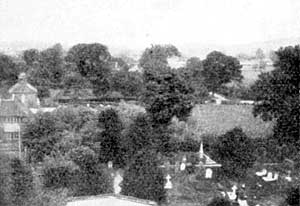Nottinghamshire Villages: Attenborough
By Alfred Parker

Attenborough Church and Ireton Farm.
RUMOURS of changes are in the air. The County Council, somewhat after the manner of St. Matthew's Centurion, are minded to say to this place, Go; and to another, Come; and, apparently, the communities concerned will, as usual, have little voice in the matter of their destination. Thus may another village lose its identity, gradually compelled to take its measure from a larger neighbour.
Let us pay Attenborough a visit while it still retains something of its individuality. Would that we could entirely recapture the pre-war detachment, when its approach was mottled by the shade of way-side elms and verging grass encroached upon the roads. 'Ere car owners, in thoughtless haste, called for hedges to be moved and, being ridded of the greenery, made the turns more dangerous by speed.
If you are more philosophical than these folk and withal, fond of a country walk, the most pleasant way to reach Attenborough is along the banks of the Trent from Nottingham, passing far-famed Clifton Grove on the opposite side of the river, turning on to the canal-side for a short stretch at Beeston Weir, whence the plain, slender spire can be seen, a point of bluish-grey rising above the trees, a little more than a mile away.
We shall cover something more than this distance if we keep to the raised flood bank of the river, for here the Trent takes a serpentine course and the features of the valley speak of it having run in other channels in past ages. Even to-day, in times of flood, it still seeks some of its early cuts, breaking through the banks to the lower meadows.
Hence, when we come opposite to the village, and turn across the fields, there are stepping-stones to negotiate.
It is significant that all the paths hereabout lead, not so much to the village as to the church, and the history of Attenborough is more particularly the story of its church. For though it is an ecclesiastical parish, it is not a civil one, being partly in Toton and partly in Chilwell and for the service of these two neighbouring communities the church was originally built. The village itself, in large part residential, boasts of but little in the way of old cottages. But one farmhouse there is, nestling by the west end of the church, which has some claim to notoriety, for here was born Henry Ireton, destined to be one of the most brilliant of the Parliamentary leaders and son-in-law of the Lord Protector, Oliver Cromwell. The farm still bears the name of this distinguished soldier, and the entry of his baptism on November 3rd, 1611, remains clearly writ in the Parish Registers.
Lord Morley ranked Ireton as one of the finest characters of his day and "so diligent in the public service . . . that he never regarded what food he ate, what clothes he wore, what horse he mounted, or at what hour he went to rest," and Cromwell, writing to Mrs. Ireton, said "That which is best worthy of love in thy husband is that of the image of Christ he bears. Look on that, and love it best."
Henry was the eldest son of German Ireton and entered a gentleman commoner of Trinity College, Oxford, in 1626. Here, the brilliant intellect which was later to make him one of the most influential men of his party, showed evidence in the fact that he took his B.A. degree when only sixteen years of age. He removed to Middle Temple and studied Law along with John Lambert, who also became a distinguished officer in the Parliamentary Army in due course.
At the time when matters came to a head between King Charles I and the Parliament, Ireton sat as Member for Appleby, in Yorkshire, but soon displayed his zeal by active participation in the affairs of the Committee formed at Nottingham, and by obtaining the removal of certain individuals who evinced Royalist tendencies.
At his own expense he raised a troop to serve under Colonel Thornhagh, but after Gainsborough fight, joined forces with Cromwell, whose influence was being more and more strongly felt in Army affairs.
Naseby saw Ireton in command of the left wing of the Parliamentary Army, which bore the shock of Prince Rupert's impetuous cavalry, and on this occasion luck aided him in escaping.

A Bird's-eye View from the Church Tower.
A letter which he wrote to his neighbour, Mr. Charlton, of Chilwell Hall, while directing the Siege of Colchester, has been quoted as showing that in spite of his dogged and indefatigable attention to military duties, he could yet find time to attend to the affairs of his estate, displaying the utmost confidence in the principles of his friend and reliance on the judgment of his mother, in whose hands he left the settlement of details which were more or less beyond his immediate control.
He also managed to write numerous pamphlets on political questions, setting forth the ideals of his party. One of these, entitled "Agreement of the People," displays an extraordinary tolerance on the subject of religious liberty, expressing the opinion that all members of the body politic should be allowed to practise their religious observances unmolested, provided they did not endeavour thereby to undermine the State.
When Cromwell went to Ireland, Ireton was appointed his deputy and carried on there after his Chief's return. So assiduous was he in the prosecution of the campaign that Cooke, the Chief Justice of Munster, described him as being "everything in the army from a foot-soldier to a General." No doubt the unremitting attention he gave to so many affairs led him to neglect his own health, and he fell a victim to disease after the taking of Limerick.
His body, brought back to England, was interred with great ceremony in the Henry VII Chapel in Westminster Abbey, his father-in-law being the chief mourner, and a stately monument, bearing the effigies of himself and his wife, being erected to his memory.
